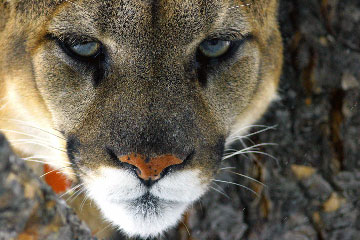High-tech collars to reveal the secretive behaviors of mountain lions
High-tech collars to reveal the secretive behaviors of mountain lions
María José Viñas, special to mongabay.com
May 28, 2008
|
|
A handful of mountain lions in the Santa Cruz Mountains of California soon will wear high-tech collars as part of a new study by researchers at the University of California, Santa Cruz. The collars will reveal not only how these animals range within their sprawling territories, but also how they hunt. The scientists aim to figure out ways to minimize conflicts between humans and mountain lions — also known as pumas and cougars.
The collars combine Global Positioning System (GPS) satellite technology with an accelerometer, an electronic chip the size of a pinkie fingernail that measures acceleration and gravity. These chips are widely available commercially, and they are already embedded in several consumer devices to detect motion. For instance, the Nintendo Wii video game system includes an accelerometer, as does the iPhone. However, this is the first time researchers will use accelerometers to study the behavior of a terrestrial mammal, says Chris Wilmers, leader of the puma tracking project and assistant professor of environmental studies at UC Santa Cruz.
 Cougar. Photo courtesy by Daniel Stahler |
“Until now, tracking collars were able to tell us where the animal was, but not what it was doing,” said Wilmers. “We hope the new collars will allow us to get new answers to questions about the animals’ behavior: how they run, how they feed, how they walk, and how they kill their prey,” he said. Mountain lions are ambush predators, Wilmers noted, making it very difficult to observe their sneaky hunting behaviors in the wild.
Other researchers agree that the study could shed new light on the elusive animals.
“This line of research can be very useful in learning about how mountain lions use their environment to survive and reproduce, which is basic to the ability of a population to persist, particularly in an environment rapidly developed by people such as California,” said Ken Logan of the Colorado Division of Wildlife, who has worked with cougars for 27 years in Wyoming, New Mexico, California, and Colorado.
The UC Santa Cruz researchers teamed up with the Felidae Conservation Fund, an environmental group, and obtained permission from the California Department of Fish and Game to conduct a five-year study of the cougars. During the first year, Wilmers’ group will trap at least five male and female pumas to fit them with the collars, then release them at the same site. The collars will not interfere with the normal behaviors of the animals, he said. Wilmers expects to expand the study to a larger number of animals and a wider territory in the second year and beyond.
 Chris Wilmers. Photo by María José Viñas |
The GPS system in the tracking collars will point out the position of the cougars every 20 minutes, allowing the scientists to delineate the felines’ home ranges. Mountain lions live alone, in territories that can go from 25 to 200 square miles. Wilmers said this information will enable his group to study how the felines behave around areas where people live, as well as to determine when and where mountain lions are most likely to run into humans or livestock
“This will allow us to focus our education and outreach efforts in the areas where we think there’s a high likelihood of human and mountain lion interaction,” Wilmers said.
The California Fish and Game Department does not keep an official census of mountain lions, but it calculates that there are between 4,000 and 6,000 cougars in the state. Puma attacks on humans are rare: there have been only 16 of them reported in California since 1890, six of them fatal. But these accidents are always widely publicized, so the public perception of the mountain lions’ danger can be distorted.
The accelerometer will constantly record the animals’ movements, and the researchers will collect this information when they retrieve the collars. The team will also calculate how many calories the mountain lions must ingest to perform their daily routines.
Terrie Williams, a professor of ecology and evolutionary biology at UC Santa Cruz, will place the same collars on mountain lions kept in captivity in zoos and other facilities, and videotape their movements. She will then correlate the observed movements with the information recorded by the accelerometer chips to match each pattern with a specific action, such as running or jumping. In this way, the researchers will know how to decipher the acceleration information obtained from the cougars in the wild. Williams applied the same technique when she used similar collars to study the behavior of dolphins and other marine mammals.
By observing the GPS positions of the cougars, the researchers also will try to locate and study the remains of the pumas’ prey. Wilmers said he’s interested in determining which species the big cats are killing, as well as the ages and genders of their prey. This will help scientists understand the impact of the cougars on their ecosystem.
Zara McDonald, executive director of the Felidae Conservation Fund, said her organization expects that a better knowledge of the behaviors of mountain lions will allow people living in cougar areas to feel more comfortable about the cats.
“We need to educate people on how to respect the mountain lions’ habitat and their need to move within their range, as we encroach more on their habitat and guarantee increased encounters,” McDonald said.
María José Viñas is a graduate student in the Science Communication Program at the University of California, Santa Cruz.